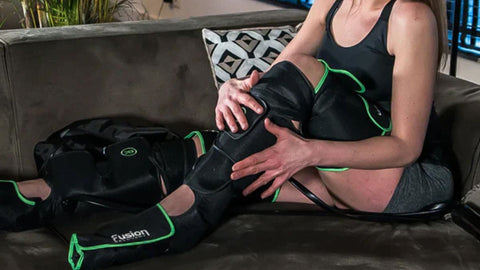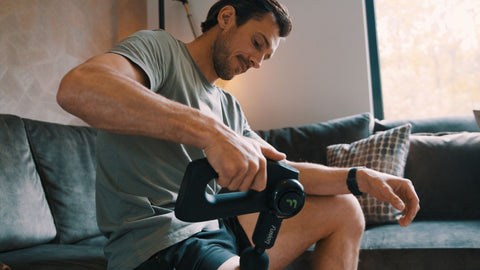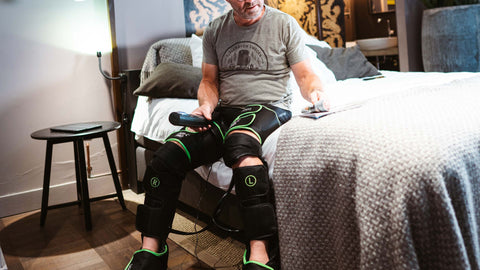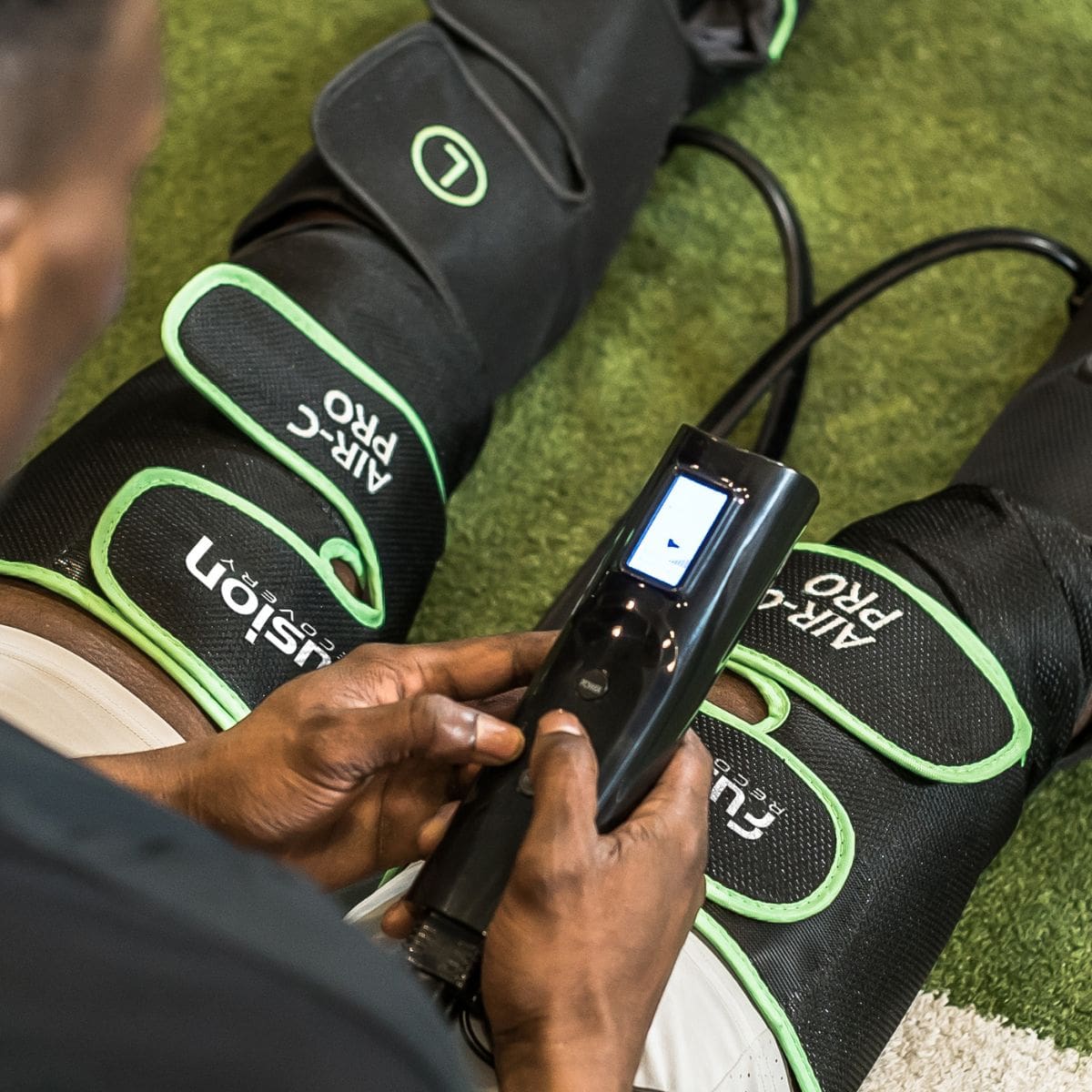Self-lymphatic massage is a simple yet effective technique that can help improve your overall health and well-being.
This massage technique uses gentle pressure to stimulate the lymphatic system, which removes waste and toxins from the body.
With a properly functioning lymphatic system, fighting off illness and disease is a lot easier. But when it becomes sluggish or blocked, it can lead to various health issues such as swelling, fatigue, and even lymphedema.
Treating yourself to a lymphatic massage is a great way to keep your lymphatic system healthy and functioning at its best. But with hundreds of lymph vessels across the body, it can be overwhelming to know where to start.
In this guide, we'll walk you through the steps to perform a self-lymphatic massage. You'll also learn about the benefits of this technique and what tools you can use to enhance the massage experience.
Steps To Perform Self Lymphatic Massage
Getting the most out of lymphatic drainage massage requires some preparation and knowledge of where your lymph nodes are located.
This network of tissues and lymphatic vessels runs throughout the body, but some areas have more lymph nodes than others. Let's look at some lymph drainage massage techniques to help you get started.
1. For the groin
Having a healthy lymphatic system in the groin area is essential for filtering toxins and waste from the genital and urinary systems. Here's how to give yourself a lymphatic massage for the groin:
Start by accessing your lymph nodes
To access the lymph nodes in your groin, lie down on your back with your knees bent and feet flat on the ground. Place one hand on your hip and use the other to feel your lymph nodes in the crease where your thigh meets your pelvis.
Use gentle pressure and motions to massage the area
Are you in position? Great! Once you've located your lymph nodes in the groin area, use your massage tool or hands to apply gentle pressure using a circular motion. Start at the top of your thigh near your hip bone and work downwards towards your knee. Be sure to cover the entire area, including the inner thigh, and down toward your pubic bone.
Repeat on the other side
Repeat the same process on the other side to ensure that both sides of your groin are stimulated evenly. Remember to use gentle pressure and circular motions, covering the entire inner thigh area and down toward your pubic bone.
2. For the legs

Massaging the legs can help to improve lymphatic flow and reduce swelling or discomfort in this area. Highly effective tools for self-lymphatic massage of the legs include massage guns. Here are the steps to follow:
Sit or lie down with your legs elevated
To start the lymphatic massage on your legs, sit or lie down with your legs elevated. This helps to increase blood flow and reduce swelling in the area.
If you're sitting, prop your feet up on a stool or footrest to be above hip level. Place a pillow under your ankles to elevate your legs if you're lying down.
Begin at the ankle
Starting at the ankle, use your hands or massage tool to apply gentle pressure and circular motions along the entire length of your leg.
Move toward your knee, paying attention to areas that feel particularly tight or swollen.
If using a massage tool, like a massage gun, start at the lowest setting and gradually increase the intensity as needed. Be sure to cover the entire leg, including the calf and thigh muscles.
Repeat this process
Repeating the self-lymphatic massage process several times is essential to properly stimulate your lymphatic system. Aim to do this massage at least once a day for optimal results.
These are just a few examples of how to treat yourself to a lymphatic drainage massage. You can adjust the techniques and tools based on your needs and preferences.
Remember, lymphatic massages are meant to be gentle and relaxing. Don't push yourself too hard or use too much pressure. This way, you can keep your lymphatic system healthy and functioning properly without causing any discomfort or sensations of pain.
Let's look into a few reasons why you might want to incorporate self-lymphatic massage into your routine.
Benefits of Self Lymphatic Massage
Performing a self-lymphatic massage can have numerous benefits for your body. Here are some of the most notable ones:
Reduces swelling
One of the main benefits of a self-lymphatic massage is its ability to reduce swelling in the body.
When your lymphatic system isn't functioning properly, fluids can build up and cause swelling in different areas, such as the legs, arms, or face. By massaging the lymph nodes, you can stimulate lymph flow and help drain excess fluid from the affected area.
This can also be helpful for individual patients with lymphedema, a condition that causes swelling in the arms or legs due to damage to the lymphatic system.
Boosts your immune system
Did you know that the lymphatic system is crucial to your immune system?
It helps to filter out toxins, waste, and other harmful substances from the body.
Promoting lymphatic drainage through self-massage can help boost your immune system's ability to fight off infections and illnesses. This can be especially beneficial during cold and flu season or when you feel run down.
You may also experience improved energy levels and overall health with a stronger immune system.
Makes your skin glow
Are you after a more youthful and radiant complexion?
Treating yourself to a self-lymphatic massage may be just what you need.
This type of massage can help improve your skin's appearance by increasing blood flow and promoting lymphatic drainage. This can reduce puffiness, dark circles, and fine lines, leaving your skin looking brighter and more refreshed.
If you're dealing with acne or other skin conditions like cellulite, a self-lymphatic massage can also help to reduce inflammation and improve overall skin health.
Eases stress and tension in your body
What better way to unwind after a long day than with a self-lymphatic massage?
When you're stressed or anxious, your body releases cortisol – a stress hormone – that can contribute to inflammation and other health issues. By promoting lymphatic drainage through massage, you can help reduce the amount of cortisol in your body and promote relaxation.
You may also experience improved sleep and a better overall sense of well-being with reduced stress and tension.
Now that you know the benefits of self-lymphatic massage, it's time to give it a try. Remember to take your time and be gentle with yourself as you work through the process. With regular practice, you'll be able to keep your lymphatic system healthy and functioning properly, leading to improved overall health and well-being.
Next, we'll go over how to prepare for a self-lymphatic massage and some tips for getting the most out of your massage session.
What to Do Before Self Lymphatic Massage
Getting the most out of your self-lymphatic massage requires a proper preparation. Here are some steps to follow before you begin:
Wear comfortable clothing
To ensure that you can easily access the lymph nodes you want to massage, it's essential to wear comfortable clothing. Opt for loose-fitting clothes made from breathable fabrics like cotton or linen.
Avoid wearing tight clothes that could restrict movement or compress lymph nodes, which could impede lymphatic drainage and make the massage less effective. Also, remove any jewelry or accessories that could get in the way.
Drink plenty of water

Another essential step to prepare for self-lymphatic massage is to drink plenty of water.
The lymphatic system relies on hydration to function properly, so keeping your body hydrated before and after the massage is essential. Drinking water helps to flush out toxins from the body and can also help reduce swelling and inflammation in the lymphatic system.
You should drink at least eight glasses of water daily, but you may need more if you are performing a massage or engaging in other physical activity.
Use a massage oil
While using fitness devices like foam rollers or massage balls can be helpful for self-massage, using a quality oil can enhance the massage experience and provide additional benefits for the skin.
Choose an oil high in essential fatty acids, such as coconut or jojoba. These oils are easily absorbed by the skin and can help improve skin hydration and elasticity.
Before applying the oil, warm it up by rubbing it between your palms. This will make it easier to apply and help promote relaxation.
Now that you know what to do to prepare for a self-lymphatic massage, how about after? Afterall, taking care of yourself post-massage is just as important as the massage itself. Let's discuss some tips for post-massage care.
What to Do After Self-Lymphatic Massage
Getting ready for a self-lymphatic massage is just as important as after-care. Here are some tips to follow after you've finished your massage:
Get enough rest
Getting enough rest after a self-lymphatic massage is crucial to allow your body to fully reap the benefits of the massage. It's recommended that you avoid strenuous physical activity and take it easy for at least an hour after the massage.
Additionally, getting a good night's sleep is essential for overall health and immune function. Aim for 7-8 hours of sleep each night to help your body recover and recharge.
Stay hydrated
Just as hydration is important before treating yourself to a lymphatic massage, it's also important after.
Drinking plenty of water helps to flush out toxins and keep the lymphatic system functioning properly.
It's recommended that you continue to drink at least eight glasses of water per day or more if you are engaging in physical activity. This will help to support the lymphatic system and prevent dehydration, which can contribute to inflammation and other health problems.
You may also consider drinking herbal teas or adding electrolyte supplements to your water to further support hydration and promote healing.
Avoid any strenuous physical activity for at least an hour
Performing a self-lymphatic massage can be a gentle and relaxing experience, but it's essential to avoid any strenuous physical activity for at least an hour after the massage.
This will give your body time to rest and recover from the massage, allowing the lymphatic system to function properly and preventing any additional stress on the body.
If you need to move your body after the massage, opt for gentle stretching or a leisurely walk to help promote circulation and relaxation.
Avoid alcohol and caffeine
While reaching for a cup of coffee or a glass of wine may be tempting after treating your body to a lymphatic massage, it's important to avoid alcohol and caffeine.
Alcohol can dehydrate the body and interfere with proper lymphatic function, while caffeine can overstimulate the body and cause inflammation.
Instead, use hydrating fluids like water, herbal teas, or electrolyte drinks to support hydration and promote healing. These fluids will help flush out toxins and keep the lymphatic system functioning properly.
These are just a few tips to help you care for your body after a self-lymphatic massage.
Remember to listen to your body and give it the rest and hydration it needs to fully reap the benefits of the massage. With regular practice, lymphatic drainage massage can become an essential part of your self-care routine, helping to support immune function and promote well-being.
Let's explore some tools you can use to enhance your self-lymphatic massage experience.
Massage Tools for Self-Lymphatic Massage
While manual lymph drainage can be done with your hands, there are also tools available that can enhance the experience and help you target specific areas of the body.
Here are some massage tools to consider:
Massage guns
Massage guns have become increasingly popular in recent years as a tool for self-massage.
These handheld devices use percussive therapy to deliver rapid bursts of pressure to the muscles, helping to relieve tension and increase circulation.
Starting with the lowest intensity setting is essential when using a massage gun for self-lymphatic massage. Focus on areas where lymph nodes are concentrated, such as the neck, armpits, and groin.
Air compression leg massagers

Air compression leg massagers are highly effective for promoting lymphatic flow in the legs and feet.
These devices use air pressure to inflate and deflate chambers around the legs, creating a wave-like massage that can help reduce swelling and improve circulation.
To use a leg massager for lymphatic drainage massage, start by putting on the sleeves or boots and adjusting the pressure to a comfortable level. Then, sit or lie down with your legs elevated and turn on the device.
Leg massagers can be used twice daily for up to 30 minutes each session.
Making these tools a part of your self-lymphatic massage routine can help enhance the effectiveness of the massage and provide additional relief for areas where lymphatic flow may be sluggish.
Fusion Recovery makes treating yourself to a self-lymphatic massage easy and effective with a wide range of percussive massage guns and air compression leg massagers. These handheld devices come with different intensity levels to allow you to customize the pressure and speed of the massage.
Using Fusion for Self Lymphatic Massage
With a wide range of lymphatic drainage tools, Fusion Recovery offers two practical options for enhancing your self-lymphatic massage experience. Here's how to use them:
Fusion Elite

It comes with five different intensity levels, allowing you to customize the pressure and speed of the massage. To massage your lymphatic system, choose an appropriate attachment and massage in circular motions around lymph node areas, such as the neck, armpits, and groin.
Fusion makes it easy to target these areas with various attachments, including the ball, bullet, fork, and flat attachments.
What makes the Elite massage gun a go-to tool for lymphatic massage is its three-length adjustable arm, which allows you to easily reach difficult-to-access areas. A powerful motor and long-lasting battery life also ensure you can enjoy a thorough massage without interruption.
Fusion Mini

Are you looking to treat yourself to a lymphatic massage on the go?
The Fusion Mini is a compact, portable massage gun that can easily fit in your pocket or purse.
Despite its small size, the Fusion Mini packs a punch with four different intensity levels and four attachments. It can be used to target lymph node areas, as well as other areas of the body that may feel tense or sore. Benefits of using the Fusion Mini for self-lymphatic massage include improved circulation and reduced swelling.
You can use it similarly to the Fusion Elite, choosing the appropriate attachment and massaging in circular motions around lymph node areas. The noiseless operation of the Fusion Mini also makes it a discreet option for use in public or at work.
Fusion Air-C Pro

If you're looking for a tool to specifically stimulate lymphatic flow in the legs and feet, the Fusion Air-C Pro leg sleeves are an excellent option.
It's a highly effective air compression leg massager that uses wave-like massage to promote lymphatic circulation and reduce swelling in the lower extremities.
Built for athletes and people with active lifestyles, the Air-C Pro comes with three different compression modus and a heat massage function to enhance your massage experience.
All this can be controlled with an easy-to-use remote, allowing you to customize the intensity and pressure of the massage. Benefits of using the Fusion Air-C Pro for self-lymphatic massage include reduced muscle soreness, improved recovery time, and increased flexibility.
People who can benefit from self-lymphatic massage include those with lymphedema, arthritis and anyone looking to improve their overall health and well-being. Let's explore just how adding self-lymphatic massage to your routine can benefit individuals with these conditions.
People Who Can Benefit from Self-Lymphatic Massage
Self-lymphatic massage can benefit a wide range of people, including those with lymphedema, chronic swelling, and poor circulation.
It can also be helpful for athletes and individuals who engage in regular physical activity as it promotes muscle recovery and reduces muscle soreness. Let's look at some specific groups who can benefit from self-lymphatic massage:
Patients with lymphedema
Lymphedema is a condition where excess fluid accumulates in the tissues, leading to swelling and discomfort.
It often occurs in individuals who have had lymph nodes removed as a result of cancer treatment.
When left untreated, it can lead to secondary lymphedema which is more difficult to manage. That's why treating your body to a massage can be beneficial for these individuals as it promotes lymphatic flow and reduces swelling.
Highly effective tools like the Fusion Air Pro C leg sleeves can be particularly helpful for these individuals, as it targets the lower extremities where lymphedema commonly occurs. Lymphedema therapist can also provide medical advice on the best self-massage techniques and tools to use.
Athletes and active individuals
Are you an athlete or someone who engages in regular physical activity? Giving yourself a lymphatic massage can be a great way to promote muscle recovery and reduce muscle soreness.
During exercise, our muscles produce waste and toxins that need to be cleared out of the body. Lymphatic massage helps to stimulate lymphatic circulation, which can improve the removal of these waste products and reduce muscle soreness.
People with sedentary lifestyles
People with sedentary lifestyles can also benefit from self-lymphatic massage. Sitting for extended periods can lead to poor circulation, which can cause swelling and discomfort in the legs and feet.
Using a tool like the Fusion Air Pro C leg sleeves can help stimulate lymphatic flow and reduce swelling in these areas. Additionally, taking short breaks throughout the day to perform self-massage can help improve circulation and prevent discomfort from prolonged sitting.
People with arthritis
Do you have a hard time dealing with arthritis pain and stiffness? Self-lymphatic massage can be an effective way to alleviate these symptoms.
Arthritis is a common condition that involves inflammation in the joints, leading to pain and stiffness. It comes with decreased blood flow and lymph passage, which can exacerbate symptoms.
Using air compression devices like leg massagers can help stimulate lymphatic flow and improve circulation in the affected areas. With regular use, you can reduce inflammation and alleviate pain and stiffness associated with arthritis.
Patients with venous Insufficiency
Venous insufficiency is a condition where the veins in the legs are unable to properly pump blood back to the heart. It's caused by weakened vein walls or valves and can affect individuals with a history of blood clots, obesity, or a sedentary lifestyle.
With venous insufficiency, the legs can become swollen and uncomfortable. Giving yourself a lymphatic massage can help stimulate lymphatic flow and improve circulation in the affected areas, reducing swelling and discomfort.
This way , you can improve your quality of life and prevent further complications from venous insufficiency.
Individuals with respiratory conditions
If you have respiratory conditions such as asthma or chronic obstructive pulmonary disease (COPD), self-lymphatic massage can also be beneficial.
These conditions can lead to fluid buildup in the lungs and chest, making breathing difficult. Giving yourself a lymphatic massage can help to improve lymph passage in these areas, promoting the removal of excess fluid and reducing respiratory symptoms.
This way, self-lymphatic massage can be a helpful complement to traditional treatments for respiratory conditions.
In the next section, we'll explore what safety precautions you should take when giving yourself lymphatic drainage.
Safety Tips to Consider When Performing Self-Lymphatic Massage
While self-lymphatic massage can have many benefits, taking some precautions to ensure safety and avoid injury is essential. Here are some tips to keep in mind:
Listen to your body and take breaks needed
When using fitness devices for self-lymphatic massage, listening to your body and taking breaks as needed is crucial. While these tools can effectively promote lymph passage and reduce swelling, overuse or misuse can lead to injuries or discomfort.
Make sure to follow the manufacturer's instructions for each device and start with a lower intensity level before increasing the pressure or speed of the massage.
Do not massage swollen or tender lymph nodes
Another essential precaution is to avoid massaging swollen or tender lymph nodes.
But how can you tell if a lymph node is swollen or tender?
Well, if you notice any pain, tenderness, redness, or swelling in a lymph node area, it's best to avoid massaging that area and seek medical attention if necessary.
Massage around the affected area instead, using light pressure to stimulate lymph flow without causing further discomfort. This way, you can still enjoy the benefits of self-lymphatic massage without exacerbating any existing health issues.
Don't massage over bony areas or joints
In addition to the precautions mentioned above, it's important to avoid massaging over bony areas or joints when using lymphatic devices like massage guns.
These areas are more sensitive and can be easily injured if too much pressure is applied.
Avoid placing it directly on bones or joints when using a massage gun or other device. Instead, focus on massaging the surrounding muscles and soft tissues to promote lymph passage.
These are just a few precautions to remember when using fitness tools for self-lymphatic massage. By following these tips and listening to your body, you can safely and effectively promote lymphatic circulation and enjoy the many benefits of self-massage.
Frequently Asked Questions
Do you still have a couple of questions about self-lymphatic massage? Here are some frequently asked questions and answers to help you out:
How often should I perform self lymphatic massage?
Treating yourself to a lymphatic massage once daily is generally recommended, but listening to your body and adjusting the frequency as needed is essential.
If you have a chronic condition such as lymphedema, you may need to perform self-massage more frequently or as directed by your physical or massage therapist. This will help to maintain circulation and reduce lymph fluid buildup.
How long does it take to see results from self lymphatic massage?
The time it takes to see results from self-lymphatic massage can vary depending on the individual and their specific condition.
Some people may notice improvements in their symptoms after just one session, while others may need to perform self-massage regularly for several weeks before seeing significant changes.
It's essential to be patient and consistent with self-massage to achieve the best results. Over time, you may notice reduced swelling, improved circulation, and decreased discomfort or pain.
Are there any side effects of self lymphatic massage?
When done correctly, self-lymphatic massage is generally considered safe and low-risk. However, there are a few potential side effects to keep in mind.
Some people may experience temporary soreness or tenderness in the area being massaged. This is normal and should subside within a day or two.
In rare cases, excessive pressure or improper massage techniques can cause bruising or tissue injury. It's essential to listen to your body and adjust the pressure and technique accordingly to avoid any discomfort or harm.
If you have any underlying health conditions, it's always a good idea to consult a physical therapist for medical advice before starting self-lymphatic massage or any other new form of exercise or therapy.
Conclusion
Self-lymphatic massage can be a great way to improve lymphatic flow and reduce swelling in the body.
It involves using gentle strokes and effective lymphatic drainage techniques to stimulate the flow of lymph fluid throughout the body's tissues and organs.
Treating your yourself to lymphatic therapy is considered safe if done correctly and in moderation. You can quickly learn how to perform this technique on yourself by following the tips and precautions mentioned in this article.
Performing self-lymphatic massage regularly depends on your needs – once a day for general wellness maintenance or more frequently if you suffer from specific conditions like edema or digestive problems.
By giving yourself a lymphatic therapy regularly, you can help improve your overall health and well-being. Let us know if you have any question!





